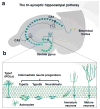The role of adult hippocampal neurogenesis in brain health and disease
- PMID: 29679070
- PMCID: PMC6195869
- DOI: 10.1038/s41380-018-0036-2
The role of adult hippocampal neurogenesis in brain health and disease
Abstract
Adult neurogenesis in the dentate gyrus of the hippocampus is highly regulated by a number of environmental and cell-intrinsic factors to adapt to environmental changes. Accumulating evidence suggests that adult-born neurons may play distinct physiological roles in hippocampus-dependent functions, such as memory encoding and mood regulation. In addition, several brain diseases, such as neurological diseases and mood disorders, have deleterious effects on adult hippocampal neurogenesis, and some symptoms of those diseases can be partially explained by the dysregulation of adult hippocampal neurogenesis. Here we review a possible link between the physiological functions of adult-born neurons and their roles in pathological conditions.
Conflict of interest statement
The authors declare there is no conflict of interest to disclose.
Figures


References
-
- Altman J. Autoradiographic investigation of cell proliferation in the brains of rats and cats. Anat Rec. 1963;145:573–591. - PubMed
-
- Altman J. Are new neurons formed in the brains of adult mammals? Science. 1962;135:1127–1128. - PubMed
-
- Kempermann G, Kuhn HG, Gage FH. More hippocampal neurons in adult mice living in an enriched environment. Nature. 1997;386:493–495. - PubMed
-
- Seki T, Arai Y. Temporal and spacial relationships between PSA-NCAM-expressing, newly generated granule cells, and radial glia-like cells in the adult dentate gyrus. J Comp Neurol. 1999;410:503–513. - PubMed
Publication types
MeSH terms
Grants and funding
LinkOut - more resources
Full Text Sources
Other Literature Sources

